The Night Sky
- DEE SHARPLES –
The Human Search for Alien Life
Are we alone in the universe?
Are there any other life forms out there or is Earth unique?
These are two of the big questions humans have been asking for thousands of years.
Since the beginning of the space age on October 4, 1957, when the Soviet Union launched Sputnik, the world’s first artificial satellite, fantastic inroads have been made in answering these questions. Space missions from several countries across the globe have since blasted off from Earth to explore our solar system’s planets and moons. Powerful Earth-based telescopes such as the Hale Telescope with its new instrument called the New Mexico Exoplanet Spectroscopic Survey Instrument (NESSI) and space telescopes such as the Hubble Space Telescope and the newly launched James Webb Space Telescope are leading the search for exoplanets, which are planets orbiting stars far beyond out solar system.
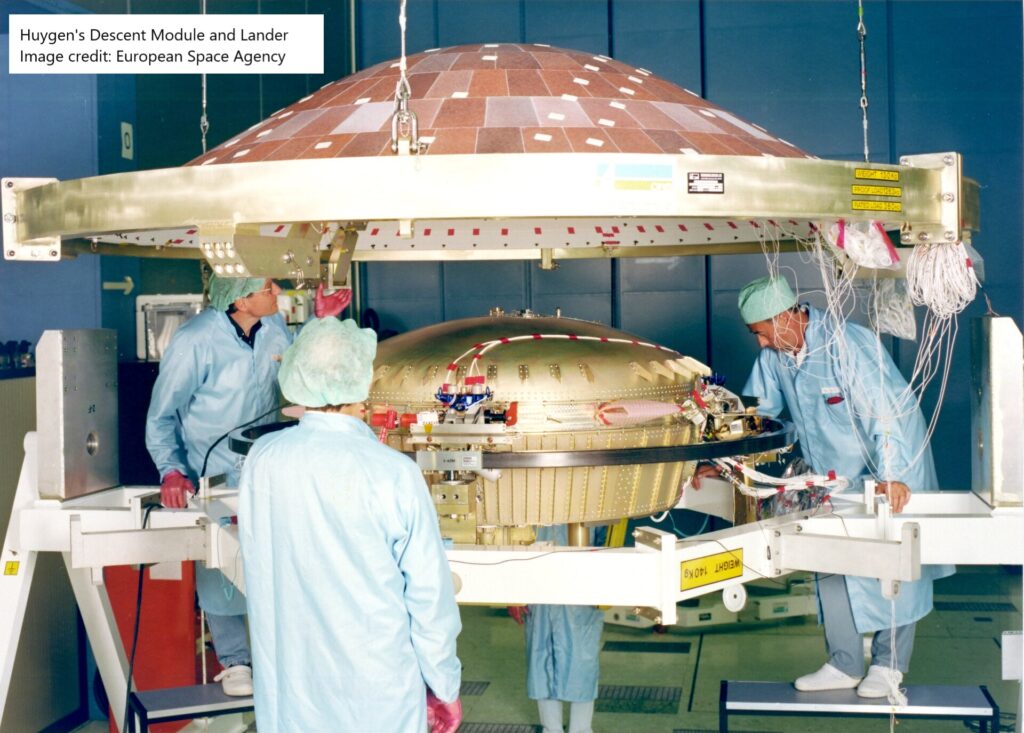
In 1992, when the first exoplanet was confirmed, it was the beginning of a new era in space exploration. Today, astronomers have announced the existence of over 4,900 planets orbiting other stars in just our Milky Way galaxy. There are another 8,400 candidates which need further study before they can be confirmed as exoplanets. According to the European Space Agency (ESA) website, ‘Astronomers estimate there are about 100 thousand million stars in the Milky Way galaxy alone. And there are millions upon millions of other galaxies in the universe!’ They, too, are likely to have planets orbiting them.
What would conditions have to be like on these worlds in order to support some form of carbon-based life as found on Earth? In addition, scientists have speculated that alien life could be based on completely different chemical elements than life on Earth. Many theories exist which we’ve only just begun to research.
But to reduce these mind-boggling numbers and questions to something more within our grasp, we only need to look in our own neighborhood. To date, observations and information gathered from all of the space missions and telescopes tantalizingly suggest that besides Earth, there are four other worlds in our solar system which have conditions suggesting evidence for some form of life, either now, in the past, or in the future. They are the planet Mars; Europa (one of Jupiter’s moons); and Titan and Enceladus (both moons orbiting Saturn). Scientists describe the ingredients needed for life as: liquid water, a source of energy (like sunlight or chemical energy), and the right chemical ingredients.
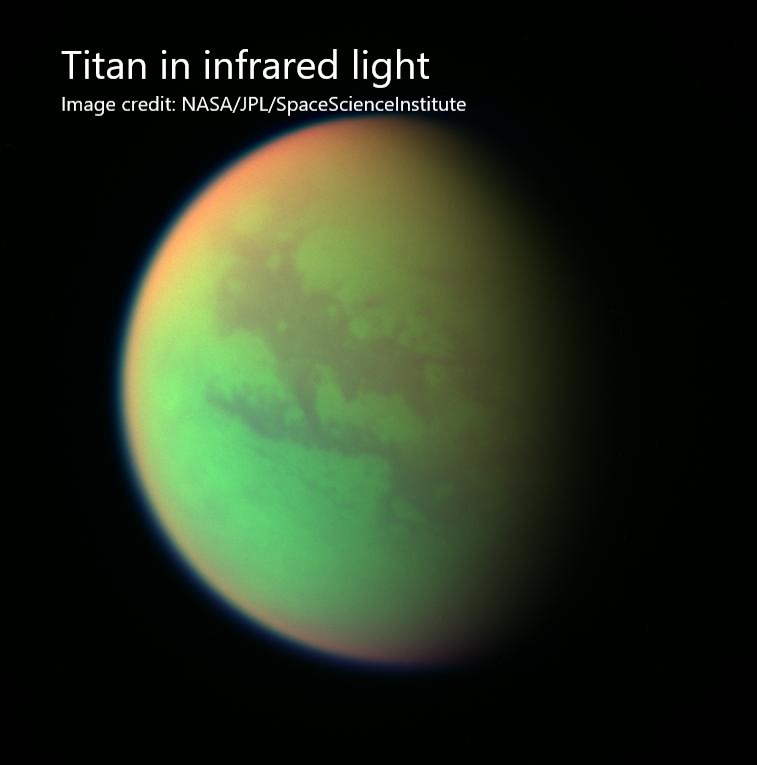
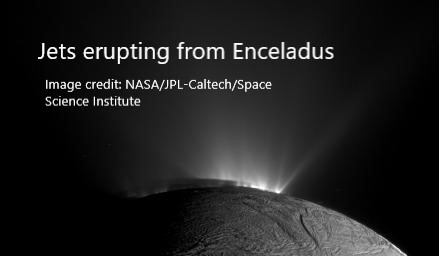
Titan, one of these worlds, was studied in greater detail during the very successful Cassini/Huygens space mission launched to the Saturnian system from Cape Canaveral on October 15, 1997. The mission was a joint endeavor by the National Aeronautical and Space Agency (NASA), the European Space Agency (ESA), and the Italian Space Agency (ASI). Huygens was the space probe designed to land on the moon Titan and Cassini was the ‘mother ship’, the main spacecraft which would study Saturn, its rings, and some of its moons.
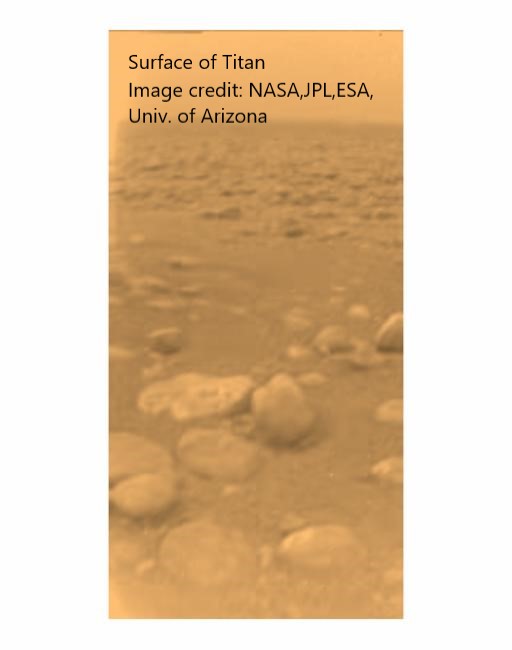
Titan is 3,200 miles in diameter, larger than the planet Mercury and is the 2nd largest moon in the solar system after Ganymede, one of the moons of Jupiter. Its atmosphere is comprised of nitrogen, methane, traces of ammonia, argon, and ethane with a surface temperature of minus 290 degrees Fahrenheit which, although extremely cold, still allows liquid methane and ethane to exist. Orbiting Saturn in almost 16 Earth-days, Titan is tidally locked, keeping one face positioned toward the planet just as our Moon does with Earth.
The Huygens probe separated from the Cassini spacecraft on December 25, 2004. It was to become the first human-made object to land on a world in the outer solar system. Its Entry Assembly Module was equipped with a heat shield which acted as a brake and thermal protection to safeguard the delicate instruments from the high temperatures encountered during its plunge through Titan’s thick atmosphere. The Entry Assembly Module was built like a shellfish 9’ wide, weighing 700 lbs. The Descent Module which was the lander was only 4’ wide and carried the scientific instruments which would do all the work. (See image on page 16.) Three parachutes released in sequence controlled its trip to the surface. When Huygens was released from Cassini, it began a 21-day final journey toward its encounter with Titan. On January 14, 2005, after a harrowing 2 hour 27 minute descent, the lander successfully touched down on the surface of Titan.
The first image taken by Huygens was awe inspiring, revealing a landscape filled with debris. A summary of the caption released with the image from photojournal.jpl.nasa.gov stated: “This image was returned on January 14, 2005, by the ESA’s Huygens probe after its successful landing on Titan. This is the colorized view after processing and gives a better indication of the actual color of the surface. Initially thought to be rocks or ice chunks, the objects imaged are more the size of pebbles 2”-4” in diameter at a distance of approximately 33” from Huygens.”
No evidence of surface liquid was found at the time of the landing. The landing site itself resembled a dried-up riverbed, with small rock-like objects resting on a dark grainy surface. The landing area showed signs of flash flooding by liquid methane/ethane (not water) which deposited these objects.
An infrared image taken by Cassini provided another view of Titan’s surface. This explanation of the various colors was provided by NASA: “Green represents areas where Cassini is able to see down to the surface. Red represents areas high in Titan’s stratosphere where atmospheric methane is absorbing sunlight. Blue along the moon’s outer edge represents visible violet wavelengths at which the upper atmosphere and detached hazes are better seen.”
Scientists believe Titan may resemble early Earth, with a complex weather system and a landscape created by flowing liquid and volcanic activity. Its atmosphere is mostly nitrogen, similar to Earth. The weather consists of wind, rain, and dust storms with surface features that change with the seasons. Titan is thought to have a prebiotic environment rich in complex organic compounds, but life as we know it cannot exist on its super cold surface. However, the moon seems to possess a global salty ocean beneath its miles-thick ice shell where conditions are potentially suitable for microbial life. Titan’s environment could become much more habitable in the distant future. As our sun transitions into an expanding red giant star five billion years from now, its surface temperature could rise high enough for Titan to maintain liquid water on its surface.
One of Saturn’s smaller moons Enceladus, only 313 miles wide, about the size of Arizona, was also a target for exploration. In 2005, the Cassini spacecraft imaged Enceladus and recorded eruptions from the moon’s surface traveling at approximately 800 miles per hour. Cassini flew 46 miles above the surface of the moon through these plumes analyzing their composition. The jets erupt from fractures in the crust and contain water vapor, carbon dioxide, methane, and a few other gases, along with salts, silica, and a high density of organic material. Scientists have determined that the moon possesses most of the chemical ingredients needed for life in the mineral-rich
water from a warm salty ocean hidden beneath its minus 330° F. icy surface.
Enceladus is locked in an orbital resonance with Dione, a slightly larger moon of Saturn. When two or more moons line up with their parent planet, they experience a gravitational interaction. Enceladus orbits Saturn twice every time Dione orbits once. Dione’s gravity stretches the orbit of Enceladus into an elliptical shape, so Enceladus is sometimes closer and other times farther from Saturn. This causes tides which flex its icy surface and create friction producing heat inside the moon. Evidence suggests there are hydrothermal vents deep beneath Enceladus’ icy shell, not unlike the hydrothermal vents that exist on the floors of Earth’s oceans. With its global ocean, unique chemistry, and internal heat, Enceladus has become a promising candidate in our search for worlds where a form of life could exist.
On September 15, 2017, Cassini ended its mission after acquiring enormous amounts of data and images. It was directed to destroy itself by plunging into Saturn to ensure it didn’t contaminate Titan or Enceladus which could possess the prebiotic chemistry to create life.
What to Look for in the Night Sky
Entire month of April: The planets Venus and Jupiter will be bright in the early morning southeastern sky before the sun rises. Mars and Saturn will join them, but both are much fainter.
April 10-30: Bright Mercury shines low in the western sky just after the sun sets, then slowly climbs higher throughout the month. Use binoculars to look for the beautiful Pleiades star cluster nearby.
April 21-22: Lyrid meteor shower. Best observing will be on April 21, 10:00 PM to 3:00 AM on the 22nd when the Moon begins to rise. (Sporadic meteors can be spotted April 16-25 when the shower is active.)
May 1: Venus and Jupiter have a spectacular morning approach visible in the eastern sky approximately 30-45 minutes before sunrise.
May 7: Eta Aquarids Meteor Shower peaks after midnight May 7 and continues into the early morning hours. (Active April 19 to May 28.) The meteors are caused by dust particles left behind by Comet Halley which burn up in our atmosphere as Earth travels through them. Meteors will appear to originate from the constellation Aquarius but can be seen streaking across the sky in any direction.
May 15-16: Total lunar eclipse. The Moon will pass through the Earth’s shadow between 10:22 PM on May 15 through 1:55 AM May 16. The sunlight illuminating the Moon will be blocked as the Earth passes between the Moon and the Sun. The Moon will be 30 degrees above the southern horizon.
May 29: Bright Jupiter has a close encounter with dimmer Mars before the Sun rises.
June 14: Supermoon. A full moon will be near its closest approach to Earth and may look slightly larger and brighter than usual.
June 21: Summer Solstice occurs at 5:13 AM. The Northern Hemisphere will experience its greatest tilt toward the Sun in 2022 officially announcing the first day of summer.
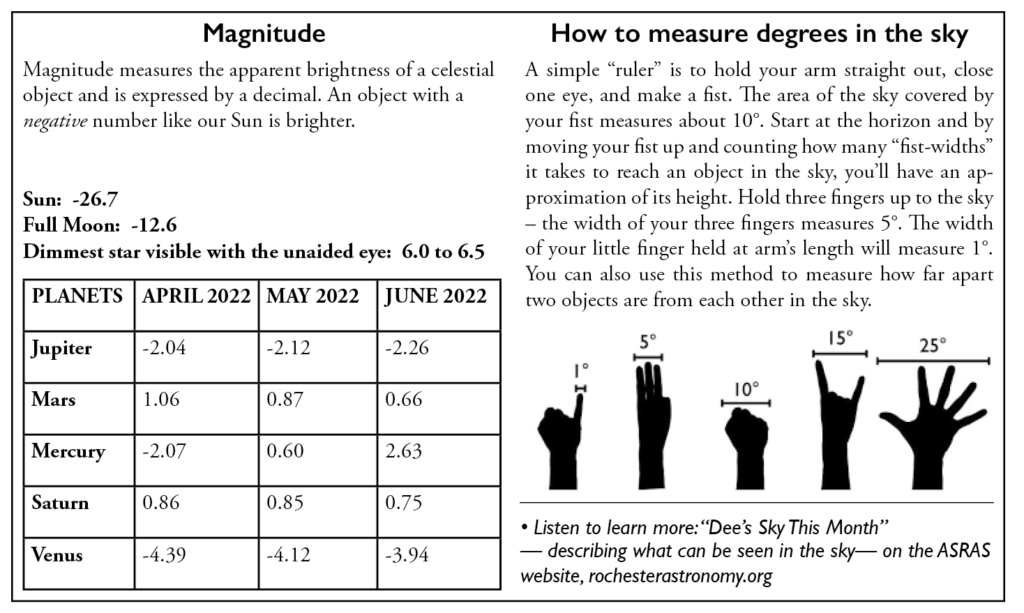
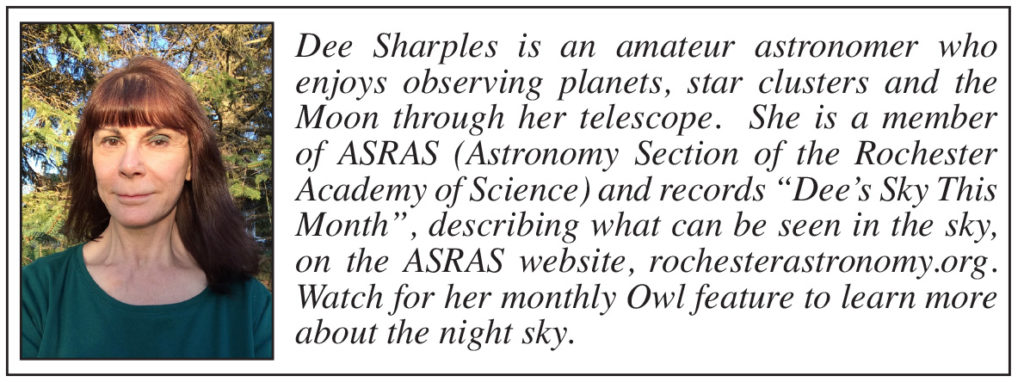
Strasenburgh Planetarium
Strasenburgh Planetarium offers the public an opportunity to observe the night sky through two large telescopes on most Saturday nights when the skies are clear.
Volunteers from the Astronomy Section of the Rochester Academy of Science will operate the telescopes from dark to 10PM. You will need to climb 60 steps to the telescope observation deck at the back of the planetarium. Call the planetarium on Saturday after 6:00 PM at 585-697-1945 to confirm this event will take place. If it’s cloudy, it will be canceled.
Observing and parking are free.